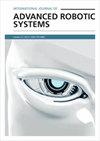悬索驱动并联机器人的SimulationX仿真
IF 2.1
4区 计算机科学
Q2 Computer Science
International Journal of Advanced Robotic Systems
Pub Date : 2023-03-01
DOI:10.1177/17298806231161463
引用次数: 0
摘要
目前,正在对一种新型的并联机器人进行研究,如缆索驱动的并联机器人。电缆驱动的并联机器人是具有柔性(电缆)、大工作空间、末端执行器具有高速度和加速度的并联机器人。在缆索驱动的并联机器人中,缆索只能在张力下工作,缆索驱动的平行机器人在受到压缩时会失去性能。这一特点严重限制了缆索驱动并联机器人的开发和应用,并需要在各种软件系统上进一步开发缆索驱动并联机械手建模。目前,Adams多体动力学软件被广泛用于创建和测试机械系统的虚拟原型。但对于电缆驱动的并联机器人建模,Adams程序相当复杂,使用成本高昂。本文在SimulationX软件上对缆索驱动并联机器人进行了仿真研究。与其他软件包不同,SimulationX更易于访问,更便宜,非常适合电缆驱动的并联机器人模拟。SimulationX上的电缆驱动并联机器人建模允许您在原型制造之前就识别出主要的设计缺陷。在SimulationX软件上,考虑到缆索的弹性耗散特性,建立了带有点质量末端执行器的悬索驱动并联机器人的模型。制造了带有点质量末端执行器的悬索驱动并联机器人原型。对带有点质量末端执行器的悬索驱动并联机器人原型的实验研究证实了该模型在SimulationX上应用于实际计算的正确性。本文章由计算机程序翻译,如有差异,请以英文原文为准。
Simulation of suspended cable-driven parallel robot on SimulationX
Currently, research is being carried out on a new type of parallel robots, such as cable-driven parallel robot. The cable-driven parallel robot are parallel robots with flexible (cables), with a large workspace, with high speeds and accelerations of the end effector. In the cable-driven parallel robot, cables can only work in tension, and cable-driven parallel robot lose their performance when they are compressed. This feature severely limits the development and application of cable-driven parallel robots and requires further development of cable-driven parallel robot modeling on various software systems. Currently, Adams multibody dynamics software is widely used to create and test virtual prototypes of mechanical systems. But for cable-driven parallel robot modeling, the Adams program is quite complex and expensive to use. In this article, the simulation of the cable-driven parallel robot is carried out on the SimulationX software. Unlike other software packages, SimulationX is more accessible and cheaper and is well suited for cable-driven parallel robot simulation. Cable-driven parallel robot modeling on SimulationX allows you to identify the main design flaws even before its prototype is made. A model on the SimulationX software of a suspended cable-driven parallel robot with a point mass end effector, taking into account the elastic-dissipative properties of cables, was developed. The prototype of suspended cable-driven parallel robot with a point mass end effector was manufactured. Experimental researches of the prototype of the suspended cable-driven parallel robot with a point mass end effector confirmed the correctness of the application of the model on SimulationX for practical calculations.
求助全文
通过发布文献求助,成功后即可免费获取论文全文。
去求助
来源期刊
CiteScore
6.50
自引率
0.00%
发文量
65
审稿时长
6 months
期刊介绍:
International Journal of Advanced Robotic Systems (IJARS) is a JCR ranked, peer-reviewed open access journal covering the full spectrum of robotics research. The journal is addressed to both practicing professionals and researchers in the field of robotics and its specialty areas. IJARS features fourteen topic areas each headed by a Topic Editor-in-Chief, integrating all aspects of research in robotics under the journal''s domain.

 求助内容:
求助内容: 应助结果提醒方式:
应助结果提醒方式:


